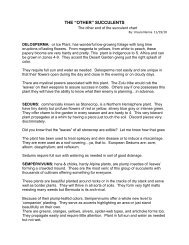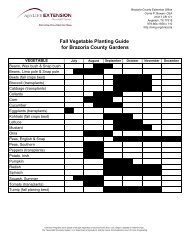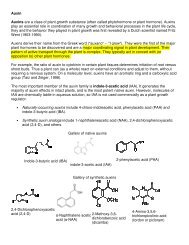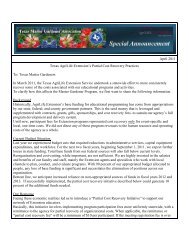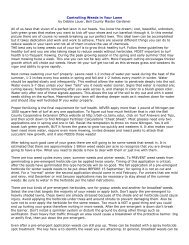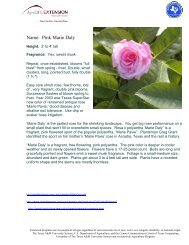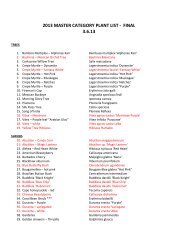Graywater - Texas Master Gardeners Association
Graywater - Texas Master Gardeners Association
Graywater - Texas Master Gardeners Association
Create successful ePaper yourself
Turn your PDF publications into a flip-book with our unique Google optimized e-Paper software.
Table 2. Estimated residential water use based on house size.<br />
No.<br />
bedrooms<br />
Size of house<br />
(square feet)<br />
Daily water use<br />
(gallons)<br />
Without watersaving<br />
devices<br />
(50%) Daily<br />
graywater<br />
production (gallons)<br />
Daily water use<br />
(gallons)<br />
With watersaving<br />
devices<br />
(50%) Daily<br />
graywater<br />
production (gallons)<br />
1 or 2 Less than 1,500 225 113 180 90<br />
3 Less than 2,500 300 150 240 120<br />
4 Less than 3,500 375 188 300 150<br />
5 Less than 4,500 450 225 360 180<br />
6 Less than 5,500 525 263 420 210<br />
can be cleaned; and<br />
meets structural requirements of<br />
the 2004 American Water Works<br />
<strong>Association</strong> (AWWA) standards.<br />
Settling tank and pump tank capacities<br />
must be adequate for estimated<br />
graywater production, expected storage<br />
time and reuse application. The<br />
graywater settling tank should hold<br />
about one day’s production volume to<br />
limit graywater detention in the tank<br />
to less than a day and to collect gross<br />
solids on the tank bottom. Inlet and<br />
outlet pipes can be close together to<br />
allow fairly direct flow between them.<br />
An effluent screen should be placed in<br />
the outlet piping to collect debris that<br />
might otherwise exit the settling tank<br />
with discharged graywater.<br />
Pump tank capacity is determined<br />
based on the pump’s minimum operating<br />
level, dose volume and alarm<br />
volume. These three factors usually<br />
equate to a pump-tank minimum<br />
volume equal to two days of flow,<br />
assuming graywater will be dosed to<br />
a distribution system daily. However,<br />
pump tanks may be larger, based on<br />
your landscape irrigation schedules.<br />
Some individuals may choose to irrigate<br />
only a couple of times a week,<br />
requiring larger tank capacity.<br />
<strong>Graywater</strong><br />
distribution<br />
Approved reuse applications.<br />
<strong>Texas</strong> graywater regulations allow<br />
graywater to be reused in the following<br />
ways:<br />
around the foundation of a new<br />
house to minimize soil movement<br />
or cracking;<br />
for gardening;<br />
for composting; or<br />
for landscaping at a single family<br />
residence.<br />
To determine the most appropriate<br />
use for graywater, consider the constituents<br />
expected to be in the water,<br />
the constituents to be removed during<br />
treatment processes, and the amount<br />
of graywater available for distribution.<br />
For example, graywater used to<br />
maintain moisture around foundations<br />
would require less treatment than<br />
would graywater used to irrigate saltsensitive<br />
trees or specimen plants.<br />
<strong>Texas</strong> graywater rules dictate<br />
acceptable methods of graywater distribution.<br />
Generally, graywater should<br />
be applied subsurface. Distribution of<br />
graywater using a spray system is forbidden.<br />
Other good-sense guidelines<br />
help protect human and environmental<br />
health:<br />
Edible root crops probably should<br />
not be irrigated with graywater.<br />
Use graywater for well-established<br />
plants rather than for<br />
seedlings.<br />
<strong>Graywater</strong> usually is slightly<br />
alkaline, so avoid using it to water<br />
plants that thrive in acidic soils.<br />
To prevent salt accumulation,<br />
distribute graywater over a large<br />
surface area and rotate distribution<br />
from one area to another.<br />
Select reuse applications appropriate<br />
for the amount of water to<br />
be generated in the system.<br />
Surface discharge exemption.<br />
<strong>Texas</strong> regulations include special rules<br />
for laundry graywater systems in use<br />
before January 6, 2005. According<br />
to 30 TAC Chapter 285 Subchapter<br />
H. Section 285.81, a homeowner that<br />
has been discharging laundry water<br />
directly onto the ground surface<br />
(without a settling tank) since before<br />
January 6, 2005, may continue to do<br />
so if the area onto which the laundry<br />
graywater is applied



